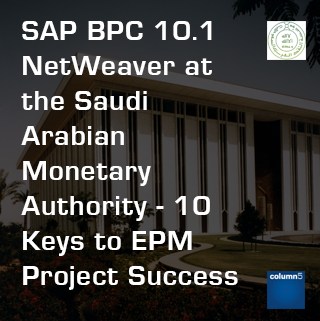 From November 2015 to November 2016, with 9 months on site, Column5 worked at the Saudi Arabian Monetary Authority (SAMA), which acts as the central bank for the KSA, to implement a Budgeting, Planning and Forecasting system using SAP BPC 10.1 NW on BW 7.4. This is the story of that implementation and the key factors behind the success of the project.
From November 2015 to November 2016, with 9 months on site, Column5 worked at the Saudi Arabian Monetary Authority (SAMA), which acts as the central bank for the KSA, to implement a Budgeting, Planning and Forecasting system using SAP BPC 10.1 NW on BW 7.4. This is the story of that implementation and the key factors behind the success of the project.
Why SAMA Wanted the Project and What We Built
Like many agencies and government departments in the Middle East, SAMA is in a process of transformation. This includes transforming their finance processes and supporting systems to make them more efficient and more effective, particularly driven by the focus on cost management that has pervaded the region with sustained oil price decline. As part of the transformation at SAMA they wished to move away from excel based budgeting and forecasting and deliver more automation, more integration, more control and more transparency across the key departments and cost centers that comprise SAMA.
A Budgeting, Planning and Forecasting system has been implemented in SAP BPC that enables driver based planning at the appropriate level of detail in separate models for Revenue, Human Resources, Operating Expenses and Capital Expenditure. The data in these models is then aggregated and integrated into a high level Finance model in BPC for senior management reporting and analysis. Final version Budget data is retracted from the Finance model to SAP BW and SAP ECC (SAMA’s transaction processing system) for detailed cost center reporting. Over 150 users will input data into the system during the budgeting and forecasting process.
Project Success Criteria
The SAMA Budgeting, Planning and Forecasting application built with SAP BPC 10.1 running on the NetWeaver platform has been delivered on time and within budget, which is a notable success for SAMA. We have identified with the SAMA team the 10 key elements that ensured the project was a success.
1. Top management sponsorshipThis is the single most important criteria for success. Without sponsorship from a company’s decision makers a project of this type will not be successful. At SAMA the top management believe-in and support finance transformation and SAP BPC as the tool to use to drive improvement to planning and forecasting processes that will benefit the whole organisation. They have dedicated appropriate resources, both in money and time spent by SAMA employees, to drive the process change and deliver the supporting SAP BPC solution. They have also clearly communicated this support to the process owner and the solution users across the whole organisation.
2. Process owner engagementThe consultants from Column5 who implemented SAP BPC at SAMA had full support from the process owner, who dedicated a large amount of his time during critical phases of the project and ensured that members of the functional team and the IT support teams were available whenever they were needed. This amounted to a considerable commitment in time from the SAMA teams. The process owner also had to commit to learning how SAP BPC works and how its supports best practice planning processes.
Without the engagement of the SAMA teams the Column5 consultants would have found it very difficult to bring the project to term on various levels.
- In order to write complete specifications that fit business needs, the SAMA functional team needed to be clear in how they wanted their future budgeting and forecasting processes to operate and to be available to answer questions from the Column5 implementation team. They needed to know what they wanted to build in BPC and this had to be clearly communicated. The Column5 team needed to be able to explain the possibilities and constraints of BPC, and how to translate the business requirements into features of the application that would appeal to the end users. This involved a very large amount of active discussion between the two teams. Without this high level of engagement it would not have been possible to finish the project on time and with a solution that fully met SAMA expectations.
- In order to complete software configuration and programming tasks in a timely manner the support and availability of the IT teams (BW and Basis) was essential. Without this the project timing would have slipped.
The implementation at SAMA was ‘greenfield’, that is to say that SAP BPC had never been implemented before, and neither had any other planning and consolidation software. This meant that we were not adapting a previous installation, with all the limitations that implies, but rather we were free to use best practice for planning process design and for SAP BPC implementation. Two weeks were spent at the beginning of the project to present SAMA Column5’s point of view on best practice planning and forecasting processes and how they are supported by BPC based on Column5’s extensive experience in this area, and how it could be best applied in this project.
This step in the implementation process was crucial for SAMA to understand the potential of SAP BPC and what best practice planning processes they wished to adopt and how this could be leveraged to their advantage in the project and produce a solution that would be well accepted and meet requirements.
4. Blueprint phaseA large part of every Column5 project is dedicated to blueprinting. In this project the blueprinting phase represented 30% of the total effort. This is because Column5 has identified through many years of experience that projects without a detailed and agreed blueprint for “to-be” planning and forecasting processes and how SAP BPC will support those processes, the projects are much more likely to fail, not fully meet expectation or are delivered late and over budget due to rework at the end of the project.
Two consultants from Column5 were dedicated to blueprinting on site in Riyadh for three months from December 2015 to March 2016. At the end of this time Column5 delivered a document to SAMA that provided clarity on to-be processes and how the BPC system what was to be built at a detailed level, to support these processes, and that was then signed off by both parties.
The blueprint document provides a solid basis upon which to develop and avoids the ‘changes in mid-project’ that do so much damage to the deliverability of those projects that have spent minimal time blueprinting.
5. Project management10% of all the hours spent by Column5 on the SAMA project were dedicated to project management. Column5 has identified, through many years’ experience that projects with insufficient project management time will fail. Project management tasks need a dedicated resource in the consulting team who understands EPM systems and processes to coordinate the implementation consultants’ work and liaise with the client. SAMA also had a Project Manager dedicated to the project to follow up progress based on the project plan and milestones, and to liaise with the consulting team and across the SAMA teams and stakeholders.
The Project Managers’ job is to raise red flags when any issues threaten to delay the project or increase its costs, and to escalate these to top management for resolution if need be. Without this role projects risk falling behind and being delivered late, and at SAMA this has been successfully avoided. On the SAMA project the Project Managers also had a key role in working with the SAMA stakeholders and the Column5 consultants to create realistic implementation resource estimates which gave the right level of focus on all key stages of the project, from blueprint, to configuration and through to testing, training and organizational change management.
As the project progresses, project costs follow up, resource utilization and control is another job that the project manager carries out. If this is not done the project can easily run over budget.
Related: EPM Project Management Methodologies Untangled
6. Consultants with deep experience of planning processes as well as BPCThe two implementation consultants who carried out the work at SAMA both have years of experience as controllers in large companies as well as being certified SAP BPC experts. This ‘dual competency’ is a key because it allows the consultants to bring in-depth knowledge of the planning and forecasting process to the project and to communicate easily with the client in terms everyone understands.
Consultants with a more technical profile were also involved in the project for integration with BW and basis configuration to round out the complete skill set needed: Finance process Functional knowledge, SAP BPC expertise, BW integration and Basis configuration. A project where any of these competencies is missing or resourced inadequately will risk failure.
7. Build team working closely with key users to verify design detailThe implementation consultants worked closely with the SAMA functional team on site in Riyadh for the whole duration of the project. A very high level of communication was maintained throughout the project and all design decisions were taken with the input of the SAMA functional team and key stakeholders.
During the final month of the realisation phase a ‘war room’ was set up where all the key actors from both the SAMA and Column5 teams could sit together to ensure a very agile response to any issues that arose from end user acceptance testing and training. This close cooperation avoided misunderstandings and enabled the teams to deliver on time without any last minute rush and facilitated extensive knowledge sharing as the project developed.
8. Good IT engagement, support and teamworkIn a project which was owned and run by the SAMA business team the engagement of the IT team was essential for integration with BW. In some companies there can be conflict between the needs of the Business team and IT as they have different views on resourcing and skills for projects. This was avoided in this project as the IT team was fully engaged, with very high availability and great teamwork, despite it not being a project run directly by the IT department. This has been another of the key factors of success at SAMA.
9. Plenty of testingThe project plan for the SAP BPC implementation at SAMA included phases for Unit Testing (UT), systems integration testing (SIT), where the Column5 consultants tested that the data flows through the system correctly, and for user acceptance testing (UAT) where users tested that the system works as expected and meets all business requirements.
All of the work which has been developed by Column5 was fully tested by the SAMA business team through a number of cycles. For instance, the Business Process Flows we configured were tested through 15 iterations ensuring that surprises at go-live are avoided. Adequate time for testing had been built into the plan from the start of the project so that this level of testing could be executed successfully.
10. Knowledge transfer, training and user engagement and change managementThroughout the project knowledge was constantly being transferred from the Column5 consultants to the SAMA team. A dedicated resource (one FTE) was assigned from SAMA to ‘shadow’ the development process and gain understanding of how the system was being built up. This informal knowledge transfer was also backed up by formal training on a wider scale.
Time and resources were allocated for training in the project plan.
- The SAMA business team attended a 7 day classroom course covering administration and reporting run by Column5 in London
- The SAMA IT team attended a 5 day classroom course run by Column5 covering administration and a shorter reporting module at SAMA offices in Riyadh
- SAMA end-users attended one day sessions prepared and run by the SAMA Business team at the Institute of Finance training centre in Riyadh
- An Arabic speaking resource joined the Column5 team for helping with the translation of key schedules and reports into Arabic, it was important for wide user acceptance that both Arabic and English access was delivered and also that this relatively new feature of switching from English to Arabic in SAP BPC was fully tested
Training ensures that end users understand how the system works and how they are expected to interact with it as they execute the new planning and forecasting processes. User acceptance is one of the most important key indicators of the success of a project of this type. All the good work which has gone before is undone if the users do not like the system delivered and therefore do not use it, or worse, misuse it. Training is a key factor in ensuring that this does not happen.
Summary of the Keys to Success
In conclusion, successfully delivering a SAP BPC project on time and within original budget involves doing a good job in all the 10 key steps, and the effort is worthwhile. It makes for a successful project, ensures wide user adoption and a sense of ownership by all the stakeholders and delivers successful transformation of key finance processes. In all, meeting the projects objectives and delivering on its business case which enhances the SAMA organisation significantly.
We should leave the last word on the project to Mr. Sami A. AlForaih, the key Finance Stakeholder on the project and Financial Planning and Budgeting Manager at SAMA:
“We set out to significantly improve our planning, budgeting and performance reporting and monitoring processes with the SAP BPC project. But, we also knew it was not just about successfully implementing the new technology but also thinking about how our new processes should operate across our finance teams to add more control and insight into our finance operations and performance management, while integrating with our new SAP ECC solution.
The project has been very successful and we have worked very closely with Column5 in delivering the project. I am quite clear that these top ten project success criteria, well implemented, with a good SAMA team and a strong consulting partner, really has made our BPC project a great success”.
Learn about more success stories here!
Related Articles:
How to Calculate Return on Investment for SAP BPC Projects
11 Dirty Secrets of EPM Projects
What is YOUR BPC Upgrade Strategy?
BREXIT and the Benefits of Constant Currency Reporting
Author Bio:
 Richard Hynes has been with Column5 Consulting as a Senior Consultant since 2014 and is one of our most popular bloggers, and is also a published author in print with technical books on Microsoft Excel and Database Programming with .NET. He is a trilingual BI professional with a double competency in Finance and IT. Hynes works on the UK team and works with various clients in EMEA.
Richard Hynes has been with Column5 Consulting as a Senior Consultant since 2014 and is one of our most popular bloggers, and is also a published author in print with technical books on Microsoft Excel and Database Programming with .NET. He is a trilingual BI professional with a double competency in Finance and IT. Hynes works on the UK team and works with various clients in EMEA.
Richard Hynes, Senior Consultant, UK Team











